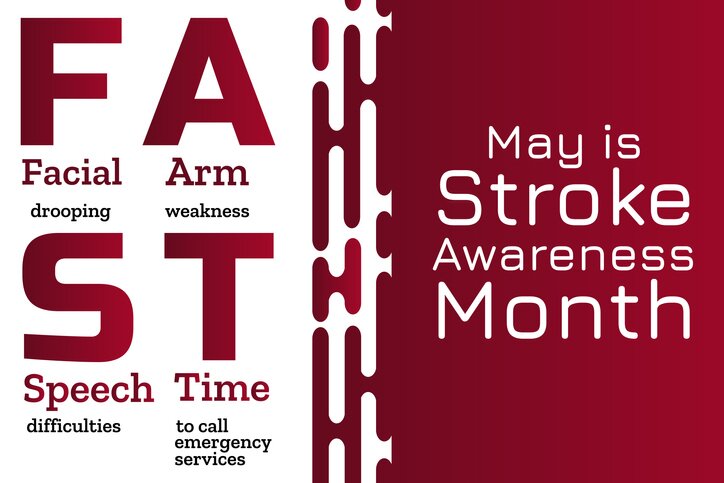It’s Stroke Awareness Month. Here are Seven Important Facts Everyone Should Know.
May is National Stroke Awareness Month, so it’s the perfect time to learn about this leading cause of death and disability in America.
Strokes or brain attacks are quite common, affecting an estimated 750,000 Americans each year. Knowing the causes and treatment could save your life or the life of a loved one.
Here are seven important stroke facts to consider.

1. Stroke occurs in the brain.
Many people mistakenly believe that stroke occurs in the heart but it actually takes place in the brain. The brain needs a constant supply of blood to carry the oxygen and nutrients it needs to function. Specific arteries supply blood to specific areas of the brain. A stroke occurs when one of these arteries gets blocked or ruptures. As a result, part of the brain does not get the blood it needs, so it starts to die.
2. Take TIAs seriously.
If an artery in the brain or going to the brain is blocked for a short time, blood flow slows down or temporarily stops. This can cause a transient ischemic attack (TIA), also known as a mini-stroke. Common symptoms of TIAs include sudden:
• Numbness, weakness or paralysis of the face, arm, or leg, usually on one side of the body
• Loss of vision in one or both eyes or double vision
• Trouble speaking or difficulty understanding others
• Loss of balance or coordination
• Severe headache with no known cause
When a TIA happens, the artery either becomes unblocked after a short time or a new path opens up and blood flow resumes. Symptoms last for a short time but a TIA is a serious warning sign that a stroke may be imminent.
3. Strokes affect people differently depending upon which side of the brain it occurs.
A stroke on the left side of the brain affects the right side of the body and may cause some or all of the following:
- Speech and language problems
- Inability to read, write and learn new information
- Impaired ability to do math or to organize, reason, and analyze
A stroke on the right side of the brain affects the left side of the body and may result in:
- Problems with depth perception or directions
- Inability to be creative, such as painting a picture or appreciating music
- Failure to recognize emotion in others’ voices
4. Knowing the F.A.S.T. acronym could save your life.
F.A.S.T. is an acronym used to teach the most common warning signs and sudden symptoms of stroke. F.A.S.T. stands for (F) face drooping, (A) arm weakness, (S) speech difficulty, (T) time to call 9-1-1. Less than half of the population is aware of the signs.
5. Anyone can have a stroke.
Data from the American Stroke Association suggests a recent spike in stroke-related hospitalizations in people between the ages of 15 and 44. In children and teens, strokes are often the result of health issues such as congenital heart defects and sickle cell disease, or blood vessel abnormalities. The risk of stroke nearly doubles every ten years after age 55. Factors such as diet, physical activity, diabetes, high cholesterol, and family history can affect your risk of having a stroke.
6. Immediate action is critical to minimize damage to the brain.
The window of opportunity for the most successful stroke treatment is just three hours after onset. One of the best treatments for ischemic strokes is quickly administering the clot-busting drug called tissue plasminogen activator (tPA). For patients experiencing hemorrhagic strokes caused by bleeding in the brain, fast action is needed to repair the leaking blood vessel.
7. Do these things to reduce your risk of stroke.
According to the American Stroke Association, up to 80 percent of strokes can be prevented. Some risk factors are out of your control, but you can reduce your risk with lifestyle changes and medical treatment.
- If you have high blood pressure, lower it. Measurement of 130/80 mm Hg and above is considered high blood pressure. If yours is high, work with your healthcare provider to manage it.
- Find out if you have atrial fibrillation (AFib). AFib is an irregular heartbeat that can lead to blood clots and cause a stroke. Your healthcare provider can tell you if you have AFib and help you manage it.
- If you smoke, stop. Smoking doubles the risk for stroke.
- If you drink alcohol, do so in moderation. Heavy drinking (more than one serving per day for women and more than two servings per day for men) can increase your risk for stroke.
- Lower your cholesterol (the fat-like substance in your blood). Studies suggest ideal total cholesterol levels at about 150 mg/dL, which equals about 100 mg/dL for low-density lipoprotein cholesterol (LDL-C). Lower cholesterol levels are linked with lower rates of heart disease and stroke.
- If you have diabetes, strive to keep your blood sugar level under control. Having diabetes puts you at an increased risk of stroke. Talk to your healthcare provider about a diet that will help you manage your diabetes, such as limiting simple carbohydrates and foods high in added sugars.
- Exercise daily. Even a little exercise—such as a brisk walk or yard work—can improve your health and may reduce your stroke risk. Check with your healthcare provider before starting a new exercise regimen.
- Cut down on sodium and saturated and trans fats. By reducing your intake of these unhealthy substances, you can lower your risk for stroke, high blood pressure, and heart disease.
May is Stroke Awareness Month, an opportunity to remember that despite amazing advances in research and clinical care, stroke continues to be the fifth leading cause of death and a leading cause of adult disability in the United States. We hope you found this information helpful. If you have questions or require additional resources, our caring staff is here for you. Please contact us anytime.
About Vaughn Greene Funeral Services: For more than 25 years, Vaughn Greene Funeral Services has been providing a ministry of care to Baltimore’s African American community. As a leading local, minority- and family-owned provider, we promise to provide our highest level of service and respect to families who entrust us to honor their loved ones. For more information about our funeral, cremation, memorial, repast, and grief counseling services, please call us at 410.655.0015 or visit us online at https://vaughncgreene.com/.







Comments